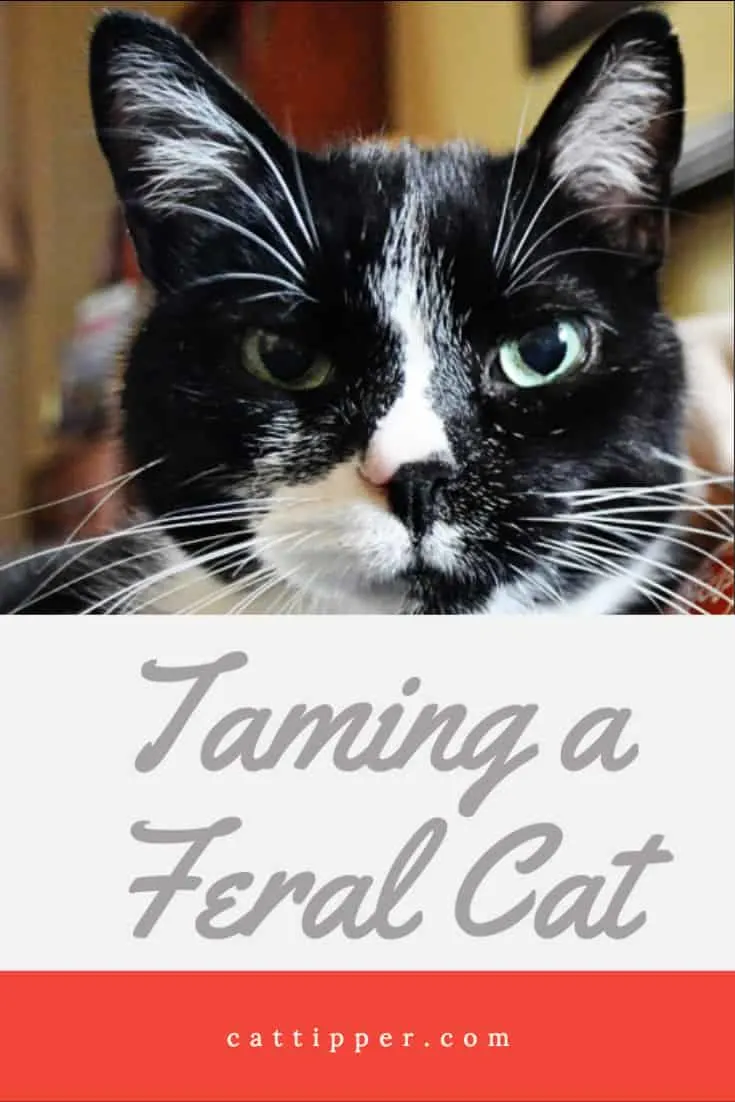
It’s anyone’s guess just how many feral cats there are (we’ve seen estimates of 50 to 70 million in the US alone)–so, as you go about your daily life, you’ve no doubt seen feral cats. Often reclusive and living in colonies (many managed by fellow cat lovers), feral cats are not previously-owned stray cats but cats who generally avoid human contact. In some communities, they are trapped, neutered and returned to their home; in other areas, they are trapped and put up for adoption, often as barn cats.
That’s exactly how Felix came into our lives.
We adopted Felix from our local city shelter shortly after our beloved KitKat died. KitKat was a black and white cat who had been dumped on our country road; he had survived removal of a brain tumor and lived several more years after that surgery. He was a dear member of our household and, with his passing, we really wanted to add another black and white cat to the family.
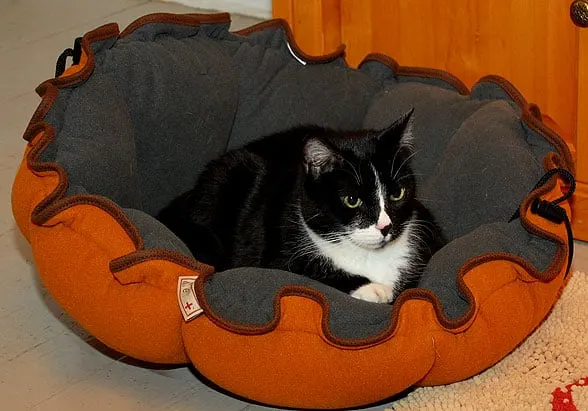
I went to visit my mother and told her I was looking for a black and white cat; she called her vet and asked if he knew of any for adoption.
As luck would have it, he had neutered a black and white cat that morning from the municipal shelter! The cat–at that time known only by a number, not a name–had been trapped in a raccoon cage by animal control. My mother and I ran by the vet’s office and he let us have a look; Felix was still under anesthesia. He was somewhere between six and eight months old and just perfect.
But the vet warned me that Felix was being neutered to be adopted as a barn cat because he was feral. “That’s OK,” I said. Yes, we have a barn but we don’t have barn cats.
Felix would be an indoor cat just like our other cats. How much different could he be, right? We soon found out.
Feral Is Not the Same As Shy
We adopted Felix and brought him home that afternoon. Felix was still groggy when we got home so I sat with him on the couch with him in my lap.
Suddenly, Felix snapped out of the remaining fog of anesthesia, saw a human, and SLAP…in a blur he struck my cheek, leaving four punctures, and he was off in a blur, headed for an open closet.
Anyone who has adopted a feral cat knows that the road to “taming” a feral cat can be a long one.
We knew that going in but we didn’t really know how long that path could be. Like many roads we start down in life, however, its twists and turns took us places we never intended to go but wouldn’t have rerouted for anything in world.
It took us weeks to touch Felix and months to pet him but, when one day Felix decided that we were OK, we forged a bond that became one of the strongest we’ve ever shared with any of our pets.
The First Week with Feral Felix
For the next week, we put water and food inside the closet, along with a nearby litter box.
During the daylight hours, there was no sign of Felix. Once we turned off all the lights at night and the house got quiet, we could see movement as Felix came out and explored.
If we turned on the lights or made any movement, he ran back in the closet.
Little By Little, Progress Was Made

The second week, we moved the food and water just outside the closet.
The third week, the bowls moved across the room.
Little by little, Felix got braver and we’d actually see him in daylight but he wouldn’t let us get close to him. At that time, we had only one other cat: sweet Elaine, a semi-feral herself who was very quiet.
Adopting an Outgoing Friend
We decided Felix needed an outgoing, sociable friend.
And so we adopted Linus. Just over a month old, Linus was everything Felix wasn’t: super outgoing, scared of nothing, a lover of people.
The shelter thought this small gray kitten was part Oriental Shorthair; he was a member of an unwanted litter, brought in with five other brothers and sisters. We chose the most outgoing kitten in the litter and brought him home.
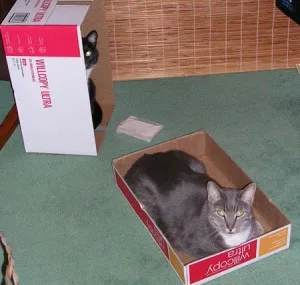
Linus instantly bonded with Felix and Elaine, and he became the link between Felix and us. Felix came closer and closer as he watched Linus playing with us with cat toys, taking treats from us, and being brushed.
Finally Felix got close enough to us to pick up (well, “grab” would be more accurate). We wrapped him a towel and sat on the couch and were finally able to pet him, with Linus at our side.
About two weeks of this towel-cocooned petting took place before Felix one day decided that maybe all humans weren’t so bad after all.
Little by little, Felix’s behavior grew more and more like our other cats. He was playful and silly and affectionate.
Holding On to Some Feral Traits
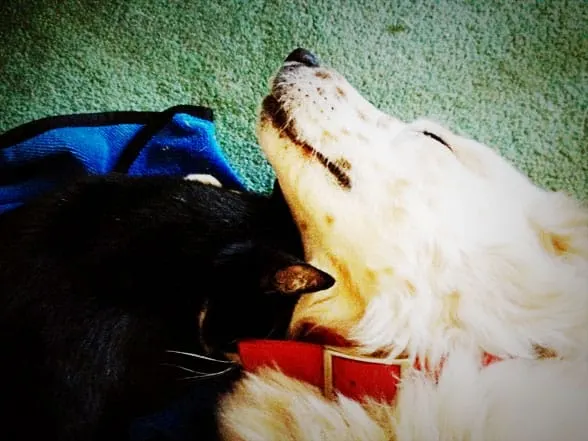
Throughout his life, Felix was like a ghost cat in our home whenever company came to visit. With just our immediate family, though, he was front and center in the action and as loving as could be to us, to our other cats, and to our dogs.
He loved us, our other cats, and our dogs. He never tried to run outside (although he loves our new catio) and was content to be a housecat along with his housemates.
Felix taught us never to make assumptions about animals. We thought he would never allow us to get close to him. Eventually he came to love nothing better than to put his front paws in our laps (never his entire body, a commitment that may have been too much after his feral beginnings.)

We assumed that, having been a feral, he wouldn’t like to play with cat toys. Felix was our most adamant laser chaser, string slapper and ball roller.
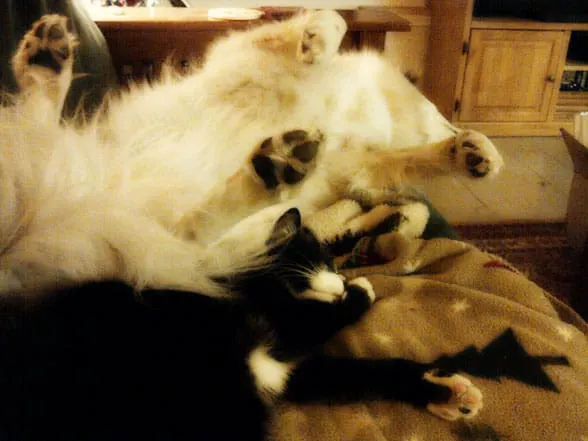
We guessed that when we adopted Irie and Tiki, he’d want to stay in our upstairs offices and out of sight of the dogs. Instead, he became best buddies with both, playing interactive dog games with Tiki and snuggling on the couch with Irie.
We taught Felix that at least some humans can be trusted.
In return, he taught us so much more. He left us a legacy of hope for all homeless pets—including those like black feral cats often deemed “less adoptable.”
Some pets just need extra time, patience, and love to become a part of a forever family and to earn a permanent place in our hearts.
Taming a feral cat takes time, patience, and love…and it doesn’t hurt to have an outgoing Linus in your life, too.
- 🎉 GIVEAWAY: Lord of the Pets Portrait of Your Cat! - November 26, 2024
- Review: Lord of the Pets Cat Portraits! - November 26, 2024
- Cat Adoption: FAQ You Might Have - June 28, 2024
